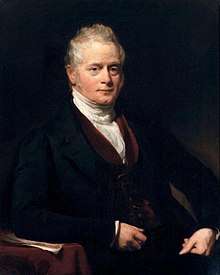Sir Edward Knatchbull, 9th Baronet
Sir Edward Knatchbull, 9th Baronet, PC, FRS (20 December 1781 – 24 May 1849) was a British Tory politician. He held office under Sir Robert Peel as Paymaster of the Forces between 1834 and 1835 and as Paymaster-General between 1841 and 1845.
Sir Edward Knatchbull | |
|---|---|
 Portrait of Knatchbull by Thomas Phillips | |
| Paymaster of the Forces | |
| In office 23 December 1834 – 8 April 1835 | |
| Monarch | William IV |
| Prime Minister | Sir Robert Peel, Bt |
| Preceded by | Lord John Russell |
| Succeeded by | Sir Henry Parnell, Bt |
| Paymaster-General | |
| In office 8 September 1841 – 1 March 1845 | |
| Monarch | Victoria |
| Prime Minister | Sir Robert Peel, Bt |
| Preceded by | Hon. Edward Stanley |
| Succeeded by | Hon. Bingham Baring |
| Personal details | |
| Born | 20 December 1781 |
| Died | 24 May 1849 (aged 67) Mersham Hatch, Kent |
| Nationality | British |
| Political party | Tory/Ultra-Tory |
| Spouse(s) | (1) Annabella Honywood (d. 1814) (2) Fanny Knight (1793-1882) |
| Alma mater | Christ Church, Oxford |
Background and education
Knatchbull was the son of Sir Edward Knatchbull, 8th Baronet, and Mary, daughter of William Western Hugessen, and was educated at Christ Church, Oxford and matriculated in 1800.[1] He was elected a Fellow of the Royal Society in 1802[2] and was called to the Bar at Lincoln's Inn in 1803. In 1819 he succeeded in the baronetcy on the death of his father.[1]
Political career
Knatchbull was elected as a Member of Parliament (MP) for Kent at a by-election in November 1819, to fill the vacancy caused by the death of his father.[3][4] He held the seat until the 1831 general election,[5] which he did not contest. The Reform Act 1832 split the Kent county constituency into Eastern and Western divisions, and at the 1831 general election Knatchbull was elected as one of the two MPs for the new Eastern division of Kent.[6] He held that seat until his resignation[7][8] in early 1845[5] by taking the Chiltern Hundreds.[7]
In 1829 he became one of the leaders of the "Ultra-Tories" who were opposed to Catholic emancipation in Ireland. Sworn of the Privy Council in 1834,[9] he served under Sir Robert Peel as Paymaster of the Forces between 1834 and 1835 and as Paymaster-General between 1841 and 1845.[10]
Family
Knatchbull married twice. His first wife was Annabella Christiana Honywood, daughter of Sir John Honywood, 4th Baronet. They married on 25 August 1806[1] and had six children:
- Mary Louisa Knatchbull (b. 1808)
- Eleanor Grace Knatchbull (d. 1913)
- Beatrice Joanna Knatchbull (d. 1932) (unsure as to accuracy of this date, this would make Beatrice approximately 122 years old when she died.)
- Mary Dorothea Knatchbull (d. 1838)
- Sir Norton Joseph Knatchbull, 10th Baronet (1808–1868)
- (child, d. 1818)
Annabella died in childbirth in 1814 and on 24 October 1820, Knatchbull married secondly Fanny Catherine Knight, daughter of Edward Knight (né Edward Austen, the brother of English novelist Jane Austen).[1] They had nine children, including:
- Edward Hugessen Knatchbull-Hugessen, 1st Baron Brabourne (1829–1893)
- Reverend Reginald Bridges Knatchbull-Hugessen (b. 1831)
- Herbert Thomas Knatchbull-Hugessen (b. 1835)
- William Western Knatchbull-Hugessen (1837–1864)[11]
Knatchbull died in May 1849, aged 67, at the family's Mersham Hatch estate in Kent, and was succeeded in the baronetcy by his son from his first marriage, Norton. Lady Knatchbull died in December 1882.[1]
References
- thepeerage.com Rt. Hon. Sir Edward Knatchbull, 9th Bt.
- "Lists of Royal Society Fellows". Retrieved 15 December 2006.
- "No. 17538". The London Gazette. 23 November 1819. p. 2090.
- Stooks Smith, Henry. (1973) [1844-1850]. Craig, F. W. S. (ed.). The Parliaments of England (2nd ed.). Chichester: Parliamentary Research Services. p. 157. ISBN 0-900178-13-2.
- Leigh Rayment's Historical List of MPs – Constituencies beginning with "K" (part 1)
- "No. 19009". The London Gazette. 1 January 1833. p. 4.
- "No. 20450". The London Gazette. 4 March 1845. p. 712.
- Craig, F. W. S. (1989) [1977]. British parliamentary election results 1832–1885 (2nd ed.). Chichester: Parliamentary Research Services. p. 403. ISBN 0-900178-26-4.
- "No. 19221". The London Gazette. 16 December 1834. p. 2266.
- "No. 20017". The London Gazette. 10 September 1841. p. 2274.
- William Western Knatchbull-Hugessen, Find a Grave. Retrieved 2018-10-16.
External links
- Hansard 1803–2005: contributions in Parliament by Sir Edward Knatchbull
| Parliament of the United Kingdom | ||
|---|---|---|
| Preceded by Sir Edward Knatchbull, 8th Bt William Philip Honywood |
Member of Parliament for Kent 1819–1831 With: William Philip Honywood 1819–1830 Thomas Law Hodges 1830–1831 |
Succeeded by Thomas Law Hodges Thomas Rider |
| New constituency | Member of Parliament for East Kent 1832–1845 With: John Pemberton Plumptre |
Succeeded by John Pemberton Plumptre William Deedes |
| Political offices | ||
| Preceded by Lord John Russell |
Paymaster of the Forces 1834–1835 |
Succeeded by Sir Henry Parnell, Bt |
| Preceded by Hon. Edward Stanley |
Paymaster-General 1841–1845 |
Succeeded by Hon. Bingham Baring |
| Baronetage of England | ||
| Preceded by Edward Knatchbull |
Baronet (of Mersham Hatch) 1819–1849 |
Succeeded by Norton Joseph Knatchbull |
.svg.png)
